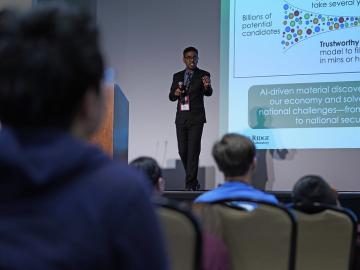
Filter News
Area of Research
- Advanced Manufacturing (3)
- Biological Systems (2)
- Biology and Environment (82)
- Biology and Soft Matter (1)
- Clean Energy (56)
- Climate and Environmental Systems (2)
- Computational Biology (1)
- Computational Engineering (2)
- Computer Science (5)
- Fusion and Fission (4)
- Fusion Energy (1)
- Isotopes (19)
- Materials (41)
- Materials for Computing (6)
- Mathematics (1)
- National Security (27)
- Neutron Science (59)
- Nuclear Science and Technology (8)
- Quantum information Science (3)
- Supercomputing (59)
- Transportation Systems (1)
News Type
News Topics
- (-) Artificial Intelligence (61)
- (-) Bioenergy (67)
- (-) Climate Change (72)
- (-) Cybersecurity (17)
- (-) Decarbonization (55)
- (-) Exascale Computing (28)
- (-) Frontier (26)
- (-) Isotopes (32)
- (-) Machine Learning (33)
- (-) Mercury (10)
- (-) Microscopy (31)
- (-) Neutron Science (74)
- (-) Security (12)
- (-) Space Exploration (22)
- 3-D Printing/Advanced Manufacturing (73)
- Advanced Reactors (21)
- Big Data (44)
- Biology (78)
- Biomedical (40)
- Biotechnology (14)
- Buildings (38)
- Chemical Sciences (35)
- Clean Water (27)
- Composites (17)
- Computer Science (127)
- Coronavirus (28)
- Critical Materials (16)
- Education (1)
- Emergency (2)
- Energy Storage (60)
- Environment (147)
- Fossil Energy (5)
- Fusion (40)
- Grid (46)
- High-Performance Computing (56)
- Hydropower (11)
- Irradiation (2)
- ITER (5)
- Materials (78)
- Materials Science (80)
- Mathematics (9)
- Microelectronics (2)
- Molten Salt (6)
- Nanotechnology (28)
- National Security (42)
- Net Zero (10)
- Nuclear Energy (74)
- Partnerships (19)
- Physics (33)
- Polymers (17)
- Quantum Computing (25)
- Quantum Science (40)
- Renewable Energy (1)
- Simulation (39)
- Software (1)
- Statistics (2)
- Summit (37)
- Sustainable Energy (92)
- Transformational Challenge Reactor (3)
- Transportation (62)
Media Contacts

The world’s fastest supercomputer helped researchers simulate synthesizing a material harder and tougher than a diamond — or any other substance on Earth. The study used Frontier to predict the likeliest strategy to synthesize such a material, thought to exist so far only within the interiors of giant exoplanets, or planets beyond our solar system.

Two ORNL teams recently completed Cohort 18 of Energy I-Corps, an immersive two-month training program where the scientists define their technology’s value propositions, conduct stakeholder discovery interviews and develop viable market pathways.

Researchers at the Department of Energy’s Oak Ridge National Laboratory and partner institutions have launched a project to develop an innovative suite of tools that will employ machine learning algorithms for more effective cybersecurity analysis of the U.S. power grid.

Researchers conduct largest, most accurate molecular dynamics simulations to date of two million correlated electrons using Frontier, the world’s fastest supercomputer. The simulation, which exceed an exaflop using full double precision, is 1,000 times greater in size and speed than any quantum chemistry simulation of it's kind.

In the wet, muddy places where America’s rivers and lands meet the sea, scientists from the Department of Energy’s Oak Ridge National Laboratory are unearthing clues to better understand how these vital landscapes are evolving under climate change.

Oak Ridge National Laboratory scientists have developed a method leveraging artificial intelligence to accelerate the identification of environmentally friendly solvents for industrial carbon capture, biomass processing, rechargeable batteries and other applications.

In May, the Department of Energy’s Oak Ridge and Brookhaven national laboratories co-hosted the 15th annual International Particle Accelerator Conference, or IPAC, at the Music City Center in Nashville, Tennessee.

Sara Martinez ensures the safety and longevity of aging structures at Oak Ridge National Laboratory, employing her engineering expertise to protect against natural disasters and extend the lifespan of critical facilities.

Researchers at Oak Ridge National Laboratory have developed free data sets to estimate how much energy any building in the contiguous U.S. will use in 2100. These data sets provide planners a way to anticipate future energy needs as the climate changes.

Prasanna Balaprakash, a national leader in artificial intelligence, or AI, spoke to some of the highest achieving students in the country at the National Science Bowl in Washington D.C.


